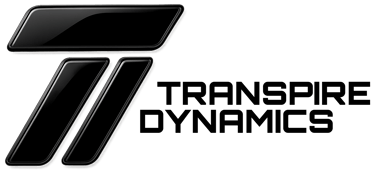
Frequently Asked Questions
What is Transpire Dynamics?
Transpire Dynamics is a technical consultancy specializing in advanced modeling, simulation, and intelligent systems solutions for complex engineering challenges across multiple industries. Our expertise spans high-fidelity simulation modeling, real-time digital environments, artificial systems, and advanced control development—serving not only aerospace, but also sectors such as automotive, robotics, energy, and industrial automation.
We operate under a principal investigator consultancy model, providing direct technical leadership and end-to-end accountability for demanding projects in simulation, systems engineering, and AI-driven innovation. By integrating rigorous engineering principles with the latest advancements in artificial intelligence and machine learning, we deliver tailored solutions that optimize performance, enhance reliability, and accelerate innovation for clients facing critical technical and operational challenges.
Who leads Transpire Dynamics?
Transpire Dynamics is led by Dong Tran, a Principal Aerospace Engineer with 16 years of proven aerospace engineering expertise. He holds a Master's degree in Aerospace Engineering from the University of Florida and maintains an active security clearance.
What makes Transpire Dynamics unique?
Our key differentiators include being a Government Purpose Rights (GPR) developer with fielded and proven flight dynamics packages, serving as an accredited flight model architect, and integrating AI-powered engineering solutions with traditional aerospace expertise. We combine deep technical expertise with the rigor of a principal investigator model.
What services does Transpire Dynamics offer?
We provide comprehensive engineering solutions including:
High Fidelity Simulations: Fully accredited six-degree-of-freedom flight-model replicas for pilot-in-the-loop training
Parametric Scenario Simulations: Machine-learning-enhanced reduced-order models that run hundreds of times faster than traditional solvers
Visual Stimulation Expertise: Immersive visual environments with advanced rendering engines for pilot training
Predictive Analytics: Real-time anomaly detection, predictive maintenance forecasting, and automated sensitivity analysis
What is the CRUSADER Project?
The CRUSADER Project is a Government Purpose Rights (GPR) physics-driven modeling architecture and environment developed by our team that is accredited in simulator devices. It features six Degrees of Freedom (6 DOF), hybridized stitched-linear, non-linear kinematic aircraft flight models for accredited flight trainers with modular components for extensibility.
What aircraft platforms do you specialize in?
We have extensive experience with multiple platforms including UH60, AH64, V22, MH60M helicopters, and various rotary-wing systems. Our expertise spans both military and civilian aircraft applications.
What programming languages and tools do you use?
Our technical stack includes:
Major Modern Programming Languages:
MATLAB/Simulink/Coder
C/C++/C#
Python
Fortran
Java
Applications:
MATLAB/Simulink/Simscape
AVL - Athena Vortex Lattice
Visual Studios
Flightlab
VBS Blue Image Generator
SolidWorks
ProEngineer
What are your core technical capabilities?
Our core competencies include:
Control law development and analysis
Modern Control Analysis and Design
Non-standard, Rotary-wing
Helicopter Modeling with Rotordynamics
Multibody Kinematics Analysis
Turbomachinery Modeling
Six-degree-of-freedom flight modeling
Real-time simulation environments
Project Management and Delivery
How do you approach project management?
We manage complex procurement processes, coordinate multidisciplinary teams, and deliver solutions that directly impact operational capabilities. Our approach emphasizes continuous verification and validation, leveraging both desktop simulations and hardware-in-the-loop (HIL) testing.
What is your development methodology?
Our technical approach is grounded in rigorous, iterative methodology that ensures both innovation and reliability. We start by defining clear project requirements and translating them into robust, physics-based mathematical models. Each phase incorporates feedback loops to optimize parameters, validate against real-world data, and ensure compliance with regulatory standards.
How can I contact Transpire Dynamics?
You can reach us at:
Phone: 1 (855) 964-4443
Email: info@transpiredynamics.com
Do you have security clearance capabilities?
Yes, our principal engineer maintains an active security clearance.
What are your typical project rates, hourly fees, or engagement models?
Pricing reflects the comprehensive value provided. Rather than a standard loaded rate, pricing is based on project complexity, strategic impact, and client objectives. This ensures you receive maximum value while maintaining cost-effectiveness. The most appropriate engagement structure highly depends on the specificity of the technical challenge.
How much do third-party licenses typically cost?
Across the industry, deployment costs per instance typically range from $10,000 - $60,000 depending on the specific applications.
Can I really deploy unlimited times with no additional fees?
Upon intellectual property delivery, the codebase and accompanying source files are yours - you can deploy limitlessly.
What are typical project durations and delivery timelines?
Project timelines vary significantly based on scope, complexity, and specific requirements. For aerospace simulation and flight dynamics work, engagements typically range from rapid modifications (2-6 months) to comprehensive new system development (12-24+ months). Each project timeline is developed through detailed analysis of technical requirements, regulatory considerations, and integration complexity. During initial consultations, a customized timeline with appropriate contingencies is provided based on your specific objectives and constraints.
Can you provide examples of past clients or case studies?
We supported major U.S. defense agencies and contractors.
Do you work with international clients or only domestic?
There are no restrictions on client locations. Engagements are supported globally with remote collaboration tools enabling effective delivery for both U.S.-based and international organizations.
Team Size: Do you work as a sole consultant or have additional team members?
Currently, all consulting, engineering, and project management services are delivered personally by the principal consultant, ensuring direct expertise and accountability on every engagement. There are plans to expand the team in the future as the consultancy grows and project needs evolve. For larger or highly specialized projects, partnerships with trusted collaborators or subcontractors may be considered to ensure seamless delivery and maintain quality standards.
Are there project size limitations?
There are no minimum or maximum project size limitations. All engagements—whether small, focused technical tasks or large, multi-phase development programs—are supported with the same level of attention and professionalism.
How do you handle IP ownership and licensing?
We assume a Client-Centric Approach. Ownership and licensing of intellectual property (IP) are determined based on the specific needs and agreements of each engagement. The default stance is flexibility—solutions can be structured so that clients retain full ownership, receive broad usage rights, or license developed technologies as appropriate.
Do you work with subcontractors or partner firms?
Services are delivered directly by the principal consultant. For larger or highly specialized projects, partnerships with trusted subcontractors or partner firms may be arranged to ensure seamless delivery and maintain quality standards. All collaborations are transparent, and clients are informed of any additional resources involved.
Do you offer training or knowledge transfer services?
Yes, training and knowledge transfer are integral parts of engagements. Services include customized technical workshops, hands-on mentorship, and development of training materials to empower client teams. These can be delivered remotely or onsite, tailored to client needs and project requirements.
What ongoing support do you provide post-delivery?
Ongoing support includes technical assistance, software updates, documentation, and integration help to ensure long-term success of delivered solutions. Flexible support arrangements—ranging from standard post-delivery support to extended service agreements—are available to match client needs. Remote and onsite support can be provided as required, and additional training or knowledge transfer is offered to empower client teams.

Transcend. Inspire. Transpire.
Contacts
© 2025. Transpire Dynamics
All rights reserved.
Phone:
Email:


